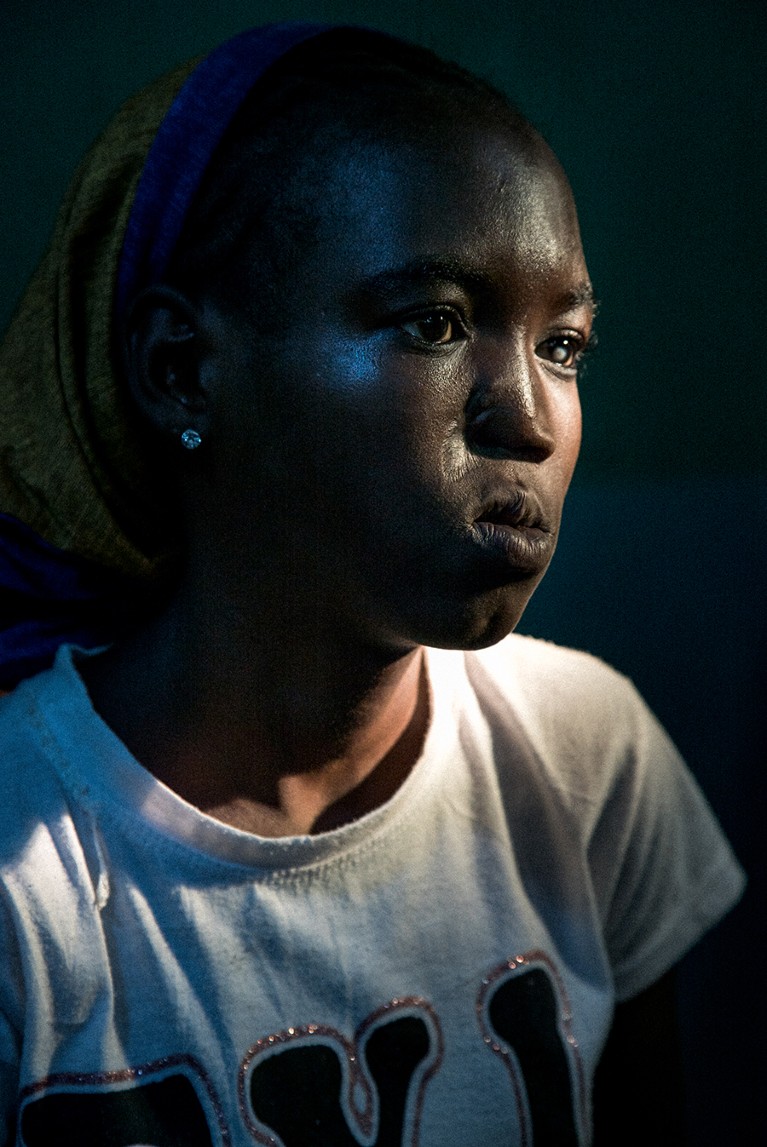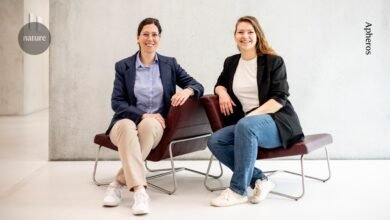

Adamu, a 14-year-old noma survivor, is screened by physicians at the Noma Hospital in Sokoto, Nigeria. Adamu’s father has been pursuing reconstructive surgery since Adamu first fell ill.Credit: Claire Jeantet and Fabrice Caterini/Inediz
The deadly condition noma is awash with contradictions. It destroys tissue and bones in the most visible part of the body — the face — yet finding cases is difficult, because people who have been affected by the illness are often hidden away owing to stigma. It is typically perceived as a disease that affects people in only certain parts of Africa, yet it was found a century ago in Europe and North America and still affects people — typically children — around the world. Although the condition can be successfully treated with antibiotics, if caught early, anyone who is not treated at this stage is very likely to die.
Noma begins as an infection in the mouth, often seen as swollen gums that fill with pus. Treatment with readily available antibiotics can stop the disease in its tracks. In the absence of early intervention, however, the infection becomes gangrenous and much tougher to treat; large parts of the face, tongue and jaw are destroyed. “From there on, you can just do wound treatment and stabilize the patient, such as giving them infusions of nutrients,” says Anaïs Galli, a researcher at the Swiss Tropical and Public Health Institute in Basel, who has collaborated on a large study of noma.
Many people who do not receive antibiotics early do not survive; mortality can be as high as 90% in this group1. “Most of them die in the gangrenous stage because you’re very prone to sepsis,” Galli says. Those who do survive might be robbed of their ability to speak.
The relative ease with which this can be avoided is a source of frustration to many. “We do not need fancy and costly treatment innovations to fight noma,” says Fidel Strub, who survived the disease. He has been working with another noma survivor, Mulikat Okanlawon, to raise awareness and help others who have experienced the disease, through an organization they co-founded called Elysium Noma Survivors Association in Stockholm. In May, the pair were named among the 100 most influential people in health in 2024 by Time magazine.
After decades of abject neglect by researchers, funders and governments, the tide might finally be turning for noma. In 2023, the World Health Organization (WHO) announced that the disease — which gets its name from the Greek word meaning to devour — would finally be included on its official list of neglected tropical diseases (NTDs). According to Stuart Ainsworth, an infectious-disease researcher at the University of Liverpool, UK, this recognition should help to usher in fresh initiatives to tackle noma.
Putting a disease on the official NTD list “provides global awareness and legitimacy in the eyes of funders and governments”, he explains — countries usually follow the WHO’s lead in deciding which diseases to prioritize. Shining an international spotlight on noma in this way, he adds, “translates into substantive increases in funding and subsequent innovation and research on new therapies and diagnostics”.
Persistent mysteries
The neglect of noma is shown in just how little is known about the condition. It is unclear, for instance, how many people are affected by it. The WHO reports that 140,000 new cases occur each year, but that figure is based on 1998 data. In 2003, a smaller estimate of 40,000 was put forth by scientists tracking incidence based on individuals in a cleft lip palate surgical centre1. The real number probably falls somewhere in the middle, says Galli.

A portrait of Blessing, a 17-year-old noma survivor, taken at Noma Hospital in Sokoto, Nigeria. Stigma around facial scarring can make finding people with the disease difficult.Credit: Claire Jeantet and Fabrice Caterini/Inediz
Galli was part of an effort to gauge the current geographical reach of noma. Historical records indicate that noma was known in classical and medieval European civilizations. Dutch physicians in the sixteenth and seventeenth centuries noted that the rapidly spreading disease affected the faces of children and was an ulceration that differed from cancer. In the next couple of centuries, people realized that the condition was linked to factors such as poverty and malnutrition. With economic progress that allowed more parents to feed their children sufficiently, as well as the advent of antibiotics, such as penicillin, in the twentieth century, noma gradually disappeared from Western countries.
Many specialists thought that the disease was now limited to what they called the noma belt. This vast swathe of territory is predominantly in the Sahel region of Africa — a band that separates the Sahara Desert to the north and tropical savannas to the south, and that includes parts of Chad, Niger and Nigeria. But Galli and her colleagues found that the truth was more complicated2. Although there is a concentration of noma cases in the Sahel, the disease is also found in many other places, including parts of Asia. In 2022, Galli and her colleagues reported an updated global distribution of noma that showed that people had been diagnosed with noma in at least 23 countries in the preceding decade.
“One of the most interesting things coming out of the literature today is the vast geographical spread of all the case reports,” says Elise Farley, an epidemiologist with international aid organization Médecins Sans Frontières (also known as Doctors Without Borders) in Cape Town, South Africa, who has studied noma extensively, including cases in Laos3. “Noma is frequently, incorrectly, framed as a disease that mainly affects children in Africa,” Farley says. In reality, she contends, it is found all around the globe.
Perhaps the most persistent mystery surrounding noma is its origins: scientists still haven’t identified the pathogen, or pathogens, that cause it. Ainsworth says that scientists have long suspected that the disease is caused by some of the same microorganisms that infect the gums in gingivitis. The corkscrew-shaped bacterium Borrelia vincentii has been implicated as a possible culprit, but so have other bacteria, and attempts to single out which one is to blame have been unsuccessful. “Every time it’s done you get a slightly different result,” Ainsworth says. “There’s no smoking gun.”
In the past few years, more scientists have begun exploring whether this murky outlook might be because noma is caused not by any one microorganism but rather by a disruption of the oral microbiome. Ainsworth is part of a team of researchers that has initiated a project to analyse samples from 20 children with acute noma in northern Nigeria. The team is applying an approach called metagenomics — a method that casts a wide net by bulk sequencing genetic material and seeing what turns up. The researchers hope that this will yield an unprecedented level of detail about which microbes are present in acute disease.
What is known is that risk factors for noma include severe malnutrition, along with weakened immunity as a result of other ailments such as HIV infection, cancer, tuberculosis or measles. Malnutrition can also weaken the body’s innate immune response, which is an essential first-line defence in mucosal barriers, such as those in the mouth. But not everywhere that experiences severe malnutrition has cases of noma. The paradox has led some scientists, including Ainsworth, to speculate that it is the absence of specific micronutrients in certain regions that might be a contributing factor. If this turns out to be true, then supplementation of those micronutrients might offer some protection.
A plan for the future
Even before the WHO’s inclusion of noma on its list of NTDs, there were signs that the research community was starting to look more closely at the condition. In the early 2000s, the number of papers published each year mentioning noma hovered in the single digits. In the past decade, however, the years in which more than a dozen noma papers were released have been more frequent. Although that’s still a small number, the increase represents a hugely significant change, says Philippe Guérin, an epidemiologist at the University of Oxford, UK, and director of the Infectious Diseases Data Observatory.

Luba cleans the wounds caused by noma on the face of her young daughter, Nasira; they live in a remote area more than 200 kilometres from the Noma Hospital in Sokoto, Nigeria.Credit: Claire Jeantet and Fabrice Caterini/Inediz
The WHO’s commitment to coordinating efforts to fight noma should only increase the attention paid to it. Although the exact amount has not yet been determined, the agency estimates it will spend US$600,000 on noma over the next two years. The money will be used to reinforce advocacy and help to carry out policy work to get noma included on the WHO’s road map for neglected diseases that charts activities through to 2030. “We see a growing interest around noma,” says Benoit Varenne, an oral-health specialist at the WHO’s department of Noncommunicable Diseases, Rehabilitation and Disability in Geneva, Switzerland.
“The inclusion of noma on WHO’s NTDs list has already been felt here,” says Abdala Atumane, who leads the oral-health department at the provincial health service of Zambezia in Mozambique. In January 2024, Atumane and his colleagues collaborated on a study with the Barcelona Institute for Global Health (ISGlobal) in Spain. All of this, he says, “has brought renewed interest in the disease to the country”. For example, Mozambique’s Ministry of Health already has plans to conduct more activities on noma. And, according to Atumane, the NTD designation has put the country’s noma efforts “on the radar” of the international community.
The results of the study have yet to be published. The preliminary findings, however, bring home the urgency of raising awareness about the disease at the local level. In a little more than three weeks of fieldwork, the team met 3 people with active cases of noma and 18 survivors. “Most of them were adults who had lived all their lives without knowing the name of the disease,” Atumane says. The results are also helping to map the need for preventive care, and highlighting gaps in care for survivors. “For existing cases, there is a great need for teams of plastic surgeons,” Atumane says.
Perhaps the most pressing challenge for scientists hoping to tackle noma, however, is finding people with the disease. Without a more active and organized search for individuals affected by the disease, and broader adoption of methods of diagnosing and categorizing cases, some researchers are concerned that the new found intensity in the fight against noma will be squandered.
The stigma that causes people to hide family members who have noma makes it harder to find cases. “You cannot deal with noma like with any other disease: the suffering and stigma are huge, and this factor needs to be taken in consideration,” Okanlawon explains. It’s also difficult to enumerate cases because the disease progresses so quickly. A person can reach the necrotizing gangrene phase in just two weeks. If they die from the infection, they might go uncounted.
Because of the challenges of finding individuals affected by noma, some scientists, including Farley, advocate for a more active approach. This might involve, for example, performing oral screenings as part of malnutrition surveys or vaccination programmes for other disease. Gallin agrees that piggybacking on existing health campaigns would be smart. These efforts “already access very remote populations, and often children in the age of noma-onset risk”, she says. “So they could screen orally, for first signs” to catch cases early enough so that antibiotics can avert the destruction of facial tissue and death.
When a person does present with symptoms, there can then be disagreement between researchers on whether the person’s oral infection can be called noma. The WHO has offered a five-stage system for categorizing cases: acute necrotizing ulcerative gingivitis, oedema, gangrene, scarring and sequela. But some medical experts have called for a simpler system. In 2022, a group of oral-health specialists argued that epidemiological studies should not count necrotizing gingivitis as a stage of noma4. That is because not all cases of necrotizing gingivitis progress to noma. To count them all as such, the authors of the paper wrote, “would make a mockery of the data about noma”.
Guérin thinks that getting researchers to agree on how to categorize and count cases of noma is essential for making progress. “If we don’t use a harmonized way to quantify it, it goes under the radar and nobody works on it,” he says.
The inclusion of noma in the WHO’s list of neglected tropical diseases could bring more consensus about how to classify stages of the disease, and bolster efforts to detect it early. According to Okanlawon, this might include awareness training for people in local communities so that they can take their children for intervention in the stages when the disease is still easy to treat. “If my grandparents knew,” she says, “they would have not allowed this to happen to me.”
Source link




